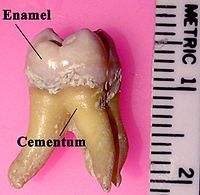
Photo from wikipedia
Abstract Ni−W−P coatings are electrodeposited from an acid gluconate bath and the effect of P addition to deposits is characterized by various physicochemical techniques. The effect of direct current (DC)… Click to show full abstract
Abstract Ni−W−P coatings are electrodeposited from an acid gluconate bath and the effect of P addition to deposits is characterized by various physicochemical techniques. The effect of direct current (DC) and pulse current (PC) deposition modes on the structure, morphology, surface roughness, and elemental oxidation states of Ni−W−P coatings is studied in details. X-ray diffraction (XRD) patterns of Ni−W−P coatings display the formation of amorphous structure, which is influenced by the addition of phosphorus. Results obtained from field emission scanning electron microscopy (FESEM) images reveal the appearance of homogeneous coarse nodular morphology for electrodeposited Ni−W−P coatings devoid of cracks. X-ray photoelectron spectroscopy (XPS) studies of Ni−W−P coatings indicate the presence of metallic and oxidized Ni species in DC-plated coatings, whereas oxidized Ni species dominate in PC-plated coatings. Microhardness values of as-deposited DC Ni−W−P coatings increase as the phosphorus content increases, whereas the values are similar for all PC Ni−W−P coatings. The effect of heat treatment on the structure and microhardness of the deposits carried at different temperatures shows a significant increase in microhardness which is comparable with hard chromium coatings.
Journal Title: Surfaces and Interfaces
Year Published: 2020
Link to full text (if available)
Share on Social Media: Sign Up to like & get
recommendations!